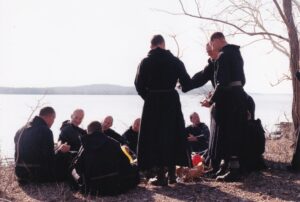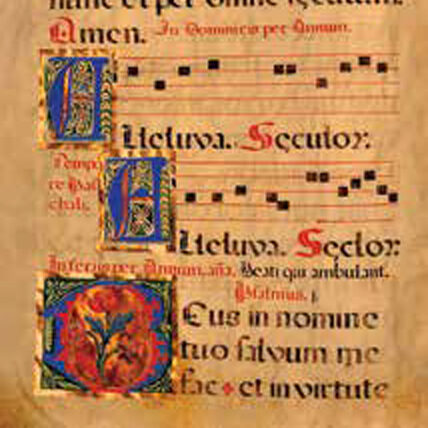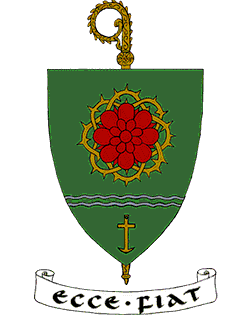Dear Friend of Clear Creek Abbey,
It was a quarter of a century ago, on the morning of September 15th well before dawn, when the founders of our monastery packed up the last of their effects and prepared to make the long journey from France to America. During the chant of the Benedictus canticle, toward the end of the office of Lauds, they assembled in the middle of the ancient abbatial church of Fontgombault and then moved out, led by the abbot,  through the open portal and into the vehicle that would take them to a train for Paris. In Paris, a place once peopled by saints and famous monasteries, they boarded a plane bound for lands across the sea.
through the open portal and into the vehicle that would take them to a train for Paris. In Paris, a place once peopled by saints and famous monasteries, they boarded a plane bound for lands across the sea.
It was rather late on this same day, the feast of Our Lady of Sorrows, that the monks finally set foot on the soil of Oklahoma. A warm reception awaited them at the Tulsa airport. Many good wishes were exchanged, as well as songs and fervent prayers. The last stage of the journey was a bit of an adventure, as the monks piled into several friendly automobiles and headed out into the heart of Cherokee County, some of the drivers getting lost amid the winding country roads, far from the city lights. It was well after midnight when all were finally assembled on what had been a family ranch, once belonging to a famous Oklahoma bootlegger.
Much has happened at Clear Creek during the past twenty-five years, and many of you have been a part of the journey. Young men have received their formation in monastic life and pronounced their vows; a few of them have been ordained to the priesthood. Beautiful buildings of considerable proportions (though still uncompleted) have risen from the ground on a spot where previously only rattlesnakes dwelled. Monks have long since labored under the intense Oklahoma sun, learning valuable skills and contributing to the building of something beautiful for God. Some of them are now wizened and bent with age.
While many monasteries in Europe and the United States have continued to suffer from a decline in vocations, God has blessed us with an abundant harvest. From the original thirteen members, we have grown to over 70 monks at present. What is the secret? God alone knows. We have no special talents or qualities, but we strive to collaborate as best we can with the graces that we have been given. It is an ongoing story.
 As we all know, an anniversary is a kind of vantage point from which one can ponder what has gone before and glimpse, perhaps, something of the future. During this next year, I hope to share with you both some photos and stories from the early days of Our Lady of Clear Creek Abbey, and some new perspectives that lie before us. You see, we figure that at twenty-five, we have only just come of age, we have only just begun.
As we all know, an anniversary is a kind of vantage point from which one can ponder what has gone before and glimpse, perhaps, something of the future. During this next year, I hope to share with you both some photos and stories from the early days of Our Lady of Clear Creek Abbey, and some new perspectives that lie before us. You see, we figure that at twenty-five, we have only just come of age, we have only just begun.
In fact, from the vantage point of an anniversary (a Silver Jubilee in our present case), one can become something of a prophet. From his own vantage point at the dawn of the Modern Age, G.K. Chesterton waxed prophetic on more than one occasion. I would like to quote here from the address an eminent Chestertonian scholar gave a few years ago:
[Chesterton] says the family will have to save civilization. In the New Dark Ages, the family will have to replace the role that was once filled by the monasteries. It will have to pass on culture and learning and art to the next generation because our institutions will no longer do that. At the same time, he says, in another paradox, when the monks come back, marriages will come back.
How painfully we see in our day the need to restore marriage to its true dignity and beauty! In this perspective, if Chesterton is right, we monks have much to do. The same Chesterton expert goes on to make another important point:
Perhaps you have heard of “The Benedict Option.” Rod Dreher gives a brilliant analysis of the New Dark Ages, and makes a compelling case for how to go about forming Christian communities. But as much as I agree with much of it, there is something about the strategy that strikes me as one of retreat rather than engagement, a siege mentality… St. Benedict did not set out to save culture. He was seeking God. The Incarnation is the center of reality. It is the truth that affects all other truths. We have to not be afraid of telling that truth. It’s worth dying for. But more importantly, it’s worth living for. (Dale Ahlquist, Commencement Address, Thomas More College of the Liberal Arts, May 20, 2017)
“It’s worth living for…” Now there is an apt description of our monastic life, a life given to something worth living (and dying) for, a life meant—not to turn inward selfishly—but to radiate around itself, while never losing what is at the center, that is to say God. What this idea of “broadcasting” (in the ancient sense of the word) of monastic influence around the monastery means is that you too are invited to be caught up in the act, whether you are a family or an individual, young or old, rich or poor.
So please be part of our Silver Jubilee during the coming year. You will not be disappointed.
br. Philip Anderson, abbot






